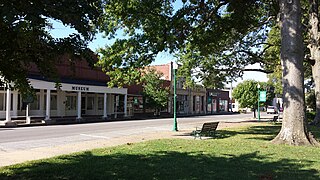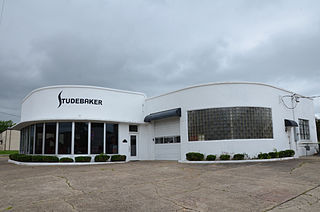
Mena is a city in Polk County, Arkansas, United States. It is also the county seat of Polk County. The population was 5,558 as of the 2020 census. Mena is included in the Ark-La-Tex socio-economic region. Surrounded by the Ouachita National Forest, Mena is a gateway to some of the most visited tourist attractions in Arkansas.

U.S. Route 71 or U.S. Highway 71 is a major north–south United States highway that extends for over 1500 miles (2500 km) in the central United States. This original 1926 route has remained largely unchanged by encroaching Interstate highways. Currently, the highway's northern terminus is in International Falls, Minnesota at the Canada–US border, at the southern end of the Fort Frances-International Falls International Bridge to Fort Frances, Ontario. U.S. Route 53 also ends here. On the other side of the bridge, Trans-Canada Highway is an east–west route while Ontario Highway 71 is a north–south route. US 71's southern terminus is between Port Barre and Krotz Springs, Louisiana at an intersection with U.S. Route 190. For the entirety south of Kansas City, Missouri, US 71 runs parallel and concurrent with the existing and future Interstate 49. North of Kansas City, US 71 runs halfway between Interstate 29 and Interstate 35, which they split in the city at an interchange with Interstate 70.

Hillcrest Historic District is a historic neighborhood in Little Rock, Arkansas that was listed on the National Register of Historic Places on December 18, 1990. It is often referred to as Hillcrest by the people who live there, although the district's boundaries actually encompass several neighborhood additions that were once part of the incorporated town of Pulaski Heights. The town of Pulaski Heights was annexed to the city of Little Rock in 1916. The Hillcrest Residents Association uses the tagline "Heart of Little Rock" because the area is located almost directly in the center of the city and was the first street car suburb in Little Rock and among the first of neighborhoods in Arkansas.

Texarkana Union Station is a historic train station in the Texarkana metropolitan area serving Amtrak, the United States' national passenger rail system. The Arkansas-Texas border bisects the structure; the eastern part, including the waiting room and ticket office, are in Texarkana, Arkansas, but the western part is in Texarkana, Texas, meaning stopped trains span both states. The station was built in 1928 and was added to the U.S. National Register of Historic Places in 1978. Today it is the second busiest Amtrak station in Arkansas.

U.S. Route 64 is a U.S. route running from Teec Nos Pos, Arizona east to Nags Head, North Carolina. In the U.S. state of Arkansas, the route runs 246.35 miles (396.46 km) from the Oklahoma border in Fort Smith east to the Tennessee border in Memphis. The route passes through several cities and towns, including Fort Smith, Clarksville, Russellville, Conway, Searcy, and West Memphis. US 64 runs parallel to Interstate 40 (I-40) until Conway, when I-40 takes a more southerly route.

Arkansas Highway 8 is a designation for four state highways in lower Arkansas. One segment runs from the Oklahoma state line east to US 59/US 71 in Mena. A second segment runs from US 59/US 71 in Mena east to US 63 in Warren. A third segment runs from US 63 at Carmel east to US 65 in Eudora. A fourth segment runs from US 65 south of Eudora to US 65 at Arkla.

The Hale Avenue Historic District encompasses a significant portion of the central business district of Osceola, Arkansas. It extends for five blocks along Hale Avenue, between Ash and Maple Streets, and includes a few buildings on adjacent streets. The focal point of the district is the Mississippi County Courthouse, and the block of buildings opposite it on Hale Avenue. Although Osceola was founded in 1875, it was relocated beginning in 1900 to be closer to the railroad, with Hale Avenue as the major east–west route. This began a period of growth in the city which continued through much of the 1920s. Most of buildings on these blocks of Hale Avenue result from this time, and a number of those built later were built in an architecturally sympathetic manner.

Twelve special routes of U.S. Route 63 currently exist. Arkansas and Missouri each contain five, with two in Iowa. There are also five former routings that have been removed from the system.
Dallas is an unincorporated community in Polk County, Arkansas, United States. The community is approximately three miles south of Mena.

U.S. Route 71 is a U.S. route that runs from Krotz Springs, LA to the Fort Frances–International Falls International Bridge at the Canadian border. In Arkansas, the highway runs from the Louisiana state line near Doddridge to the Missouri state line near Bella Vista. In Texarkana, the highway runs along State Line Avenue with US 59 and partially runs in Texas. Other areas served by the highway include Fort Smith and Northwest Arkansas.

The Paragould Downtown Commercial Historic District encompasses the historic central business district of Paragould, Arkansas. The city was organized in 1882 around the intersection of two railroad lines, which lies in the southwestern portion of this district. The main axes of the district are Court and Pruett Streets, extending along Court from 3½ Street to 3rd Avenue, and along Court from King's Highway to Highland Street, with properties also on adjacent streets. Prominent in the district are the 1888 Greene County Courthouse, built during the city's first major growth spurt. Most of the district's buildings are one and two stories in height, and of masonry construction. The National Bank of Commerce Building at 200 S. Pruett is a notable example of limestone construction, and of Classical Revival styling found in some of the buildings put up during the city's second major growth period in the 1920s.

Janssen Park is a municipal park in the heart of the city of Mena, Arkansas. It is bounded by Janssen and Port Arthur Avenues, and 9th and 7th Streets. The park is a large grassy expanse with occasional mature trees, and features walkways radiating from a central drive, which circles around Mena's oldest building, the c. 1850s Shelton log cabin. A pair of ponds are located in the park's southern quadrant, and there is a clocktower within the circle near the cabin. The park was laid out in 1896, the year of the city's founding, but was not properly developed until ten years later. The park was listed on the National Register of Historic Places in 1979.

The Mena Kansas City-Southern Depot is a historic railroad station on Sherwood Street in the center of Mena, Arkansas. It is long single-story structure, built out of brick, with a tile roof and Mediterranean styling. It was built in 1920 by the Kansas City Southern Railway to designs by the company architect, T. C. Horstmann, and is one of the most elaborate surviving early-20th century railroad stations in the state. It is now owned by the city, and houses a local history museum and the local chamber of commerce.

The Studebaker Showroom is a historic commercial building at 519 Port Arthur Avenue in downtown Mena, Arkansas. It is a single-story stuccoed concrete block structure with a flat roof. Built in 1948, it is a distinctive local example of the Moderne style, with rounded corners on the corners of the front part of the building. This includes a projecting showroom section and the corners of the main service and sales area behind, which are decorated with banks of glass blocks, another Moderne hallmark.

The Downtown Essex Junction Commercial Historic District encompasses the historically railroad-dominated portion of downtown Essex Junction, Vermont. Aligned along the south side of Railroad Avenue and adjacent portions of Main Street, the area underwent most of its development between 1900 and 1940, when Essex Junction served as a major regional railroad hub. The district was listed on the National Register of Historic Places in 2004.

The Railroad Street Historic District encompasses a cluster of commercial and railroad-related buildings at the traditional late 19th-century heart of St. Johnsbury, Vermont. It includes five commercial buildings and the town's 1883 union depot, and is reflective of the town's importance as a major railroad junction in northern New England. The district was listed on the National Register of Historic Places in 1974. It was subsumed by the larger St. Johnsbury Historic District in 1980.

The St. Johnsbury Historic District encompasses much of the historic civic and commercial center of St. Johnsbury, Vermont. Representing a significant expansion of the Railroad Street Historic District and the St. Johnsbury Main Street Historic District, it captures the historical tension and competition between Main Street and Railroad Street for primacy as the town's most important civic and commercial areas. The district was listed on the National Register of Historic Places in 1980.

The St. Johnsbury Main Street Historic District encompasses the historic civic and cultural center of the town of St. Johnsbury, Vermont. Organized along the town's Main Street, it includes high-quality architecture spanning the 19th and early 20th centuries, and includes the National Historic Landmark St. Johnsbury Athenaeum. Many of the district's buildings were designed by Lambert Packard, a prominent local architect. The district was listed on the National Register of Historic Places in 1975, and was enlarged slightly in 1976. It was subsumed into the larger St. Johnsbury Historic District in 1980.

The Portsmouth Downtown Historic District encompasses the historic urban core of Portsmouth, New Hampshire. With a history dating to the 17th century, Portsmouth was New Hampshire's principal seaport and the center of its economy for many decades, and the architecture of its urban center is reflective of nearly four centuries of history. The district is roughly L-shaped, radiating from the downtown Market Square area to South Street in the south and Madison and Columbia streets in the west, with more than 1,200 historically significant buildings. It was listed on the National Register of Historic Places in 2017. The district includes 35 previous listings on the National Register, and five National Historic Landmarks.






















